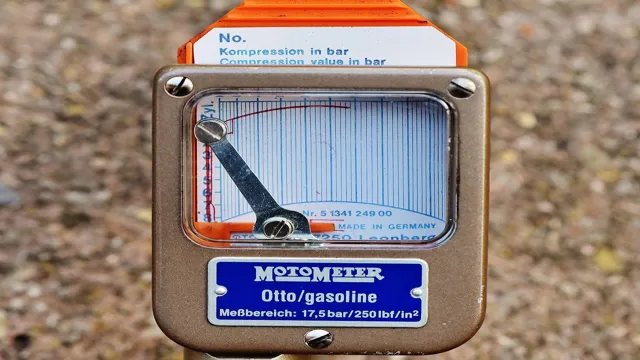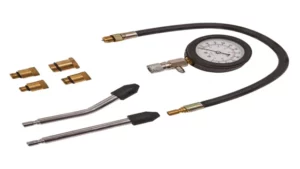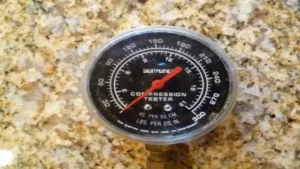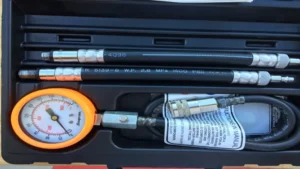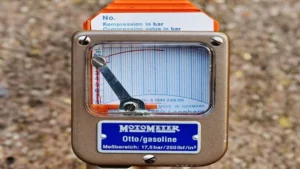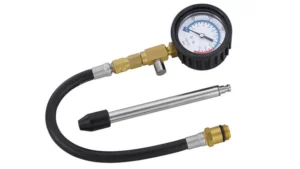If you’re experiencing engine issues, a compression tester is an important tool to help diagnose the problem. It measures the amount of pressure that builds up inside your engine’s cylinders during the combustion process. Knowing your engine’s compression levels can help you identify potential engine problems and prevent costly repairs down the line.
However, if you’ve never used a compression tester before, the tool can seem intimidating. In this article, we’ll walk you through the steps on how to use an engine compression tester like an expert. So, buckle up and get ready to learn how to keep your engine running smoothly.
What is an Engine Compression Tester?
If you are a car owner, you know how important it is to take care of your engine. One way to ensure that your engine is in good condition is by using an engine compression tester. This tool measures the compression pressure of each cylinder in your engine, which is vital to know because low compression can cause your car to run poorly or not start at all.
To use an engine compression tester, you need to first remove the spark plug from the first cylinder you want to test. Next, screw the compression tester onto the spark plug hole and have someone turn the engine over a few times while you monitor the gauge. Repeat this process for each cylinder in your engine, and compare the results to see if they fall within the recommended range.
By using an engine compression tester, you can detect any potential issues with your engine before they turn into bigger and more costly problems. So, if you want to keep your car running smoothly, invest in an engine compression tester and use it regularly to ensure that your engine is in top condition.
Definition and Function
An engine compression tester is a tool used to measure the compression level of an engine. It is a device that helps to determine the health of an engine’s internal components, specifically the pistons, piston rings, and valves. The compression tester works by measuring the pressure produced when the engine is cranked, allowing you to determine if there is any damage or wear to the engine’s internal components.
This tool is a must-have for mechanics and car enthusiasts as it helps to diagnose issues before they escalate into more significant problems. The engine compression tester can be likened to a doctor’s stethoscope, used to examine the body of a patient and accurately diagnose any underlying conditions. By using an engine compression tester, you can identify issues early on, ensuring your engine runs smoothly for years to come.
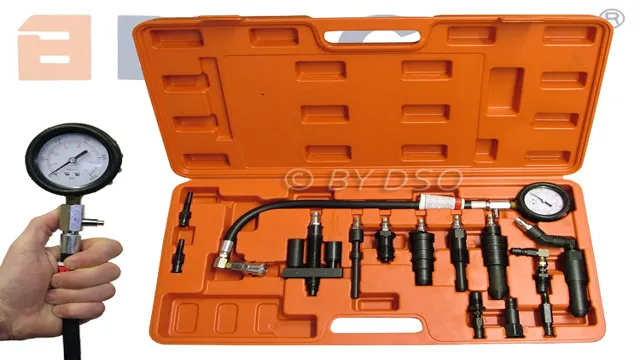
Types of Engine Compression Testers
An engine compression tester is a device used to test the compression level in an engine. It measures the pressure generated by the engine’s pistons and cylinders during the combustion process. With this tool, car mechanics can diagnose engine problems and make necessary adjustments or repairs.
There are two types of engine compression testers: mechanical and electronic. Mechanical compression testers are simple to use and accurate, but they require manual interpretation of the results. In contrast, electronic compression testers provide a digital readout and additional features such as data storage and analysis.
Overall, engine compression testers are essential tools for maintaining a healthy engine and preventing costly repairs. So if you’re a DIY car enthusiast or a professional mechanic, investing in one will undoubtedly pay dividends in the long run.
When and Why to Use an Engine Compression Tester?
Using an engine compression tester is a valuable tool when it comes to diagnosing any potential problems with your engine. Compression tests are typically done as part of regular maintenance or when there’s an issue like low power or misfires. The process involves removing the spark plugs and attaching the compression tester to the cylinder head.
You then crank the engine and the tester measures the pressure inside the cylinder. If there is a significant difference between cylinders, it could indicate a problem like a worn valve or piston rings. By using a compression tester, you can save money and time on costly engine repairs by identifying and addressing issues early on.
Remember, regular use also helps you keep tabs on your engine’s overall health and prolong its life.
Symptoms That Require Engine Compression Test
An engine compression test is a crucial diagnostic tool used to identify issues related to engine performance. Some symptoms that require an engine compression test include excessive smoking, difficulty starting the engine, rough idle, loss of power, and decreased fuel efficiency. The test measures the pressure produced by the engine’s pistons and determines whether the engine is in good condition or needs repair.
It’s important to use an engine compression tester at the first sign of any problems to prevent further damage to the engine. By identifying the cause of the issue, you can save yourself time and money by addressing the root problem instead of just the symptoms. So, if you’re experiencing any of these symptoms, don’t wait – use an engine compression tester to diagnose the problem and get your engine running smoothly again.
Benefits of Using an Engine Compression Test
An engine compression test is an essential tool for any car owner or mechanic looking to diagnose engine problems. It involves measuring the pressure inside the cylinders to determine if there are any issues with the engine’s performance. But when and why should you use an engine compression tester? The answer is simple: whenever you notice a decrease in your engine’s power or performance.
This could be due to a number of reasons, including worn-out piston rings or a damaged head gasket. By performing an engine compression test, you can identify the root cause of the issue and take proactive steps to fix it. The benefits of using an engine compression tester are numerous.
It not only helps diagnose engine problems but also saves time and money by pinpointing the specific issue and preventing unnecessary repairs. It also helps you maintain your engine’s overall health by ensuring that all cylinders are working at optimal levels, thereby improving fuel efficiency and preventing future issues. In short, if you want to keep your engine running smoothly, an engine compression test is a must-have tool in your toolkit.
Step-by-Step Guide to Use an Engine Compression Tester
If you want to find out if your engine is running at its best, then using an engine compression tester can help. Below is a step-by-step guide on how to use an engine compression tester. First, start by warming up your engine, as this will ensure the readings are accurate.
Once warm, remove all the spark plugs to access the cylinders. Next, insert the tester into the first cylinder and press it down firmly. Crank the engine for about five to eight compression strokes and then record the results.
Repeat this process for all the cylinders, making sure to record each reading. After recording all the readings, compare them to the manufacturer’s specifications. If the readings are not within the recommended range, then it could indicate internal engine problems.
Overall, using an engine compression tester is an easy and effective way to keep your engine running smoothly.
Preparing the Vehicle for the Test
Before using an engine compression tester, it is essential to prepare the vehicle adequately. Start by making sure the engine is warm but turned off, disconnecting the ignition coil, and removing the spark plugs. This will make it easier to turn the engine and give you more accuracy in your readings.
Once you have the tester attached, turn the engine over, and take note of the reading on the gauge. Repeat this process for each cylinder in the engine and compare the results. If you notice significant differences between the cylinders, there may be an issue with your engine’s compression.
One thing to keep in mind is that every engine is different, so it’s crucial to consult your vehicle manual to determine the recommended compression levels for your engine. With a step-by-step guide and some prep work, using an engine compression tester can be a quick and easy way to check your engine’s health.
Locating the Spark Plugs
Locating the spark plugs may seem like a daunting task for beginners, but with the right tools and a little bit of know-how, this can be easily achieved. Firstly, open up the hood of your car and locate the engine. The spark plugs will be attached to the engine and can usually be found near the cylinder head.
Depending on the vehicle, there may be anywhere from four to eight spark plugs that need to be checked. To locate the exact position of each spark plug, refer to your car’s user manual for specific instructions. It is important to replace the spark plugs regularly to ensure optimal engine performance and prevent further damage.
By following this simple guide, you can quickly locate and check the condition of your spark plugs, giving you peace of mind and a better understanding of your car’s health.
Screwing in the Compression Tester
If you’re looking to check the health of your engine, using an engine compression tester is a great way to measure the compression levels of each cylinder. However, it’s essential to understand how to use it correctly to get accurate results. One crucial step is screwing in the compression tester into the spark plug hole tightly.
It’s vital to ensure that the tester is securely screwed in to prevent any air from escaping, which can affect the readings. Use your hands to screw in the tester first and then use a tool to tighten it further. You also need to make sure that the tester’s O-ring is in good condition and free of any cracks, as it helps to provide a good seal.
Once tightly screwed, turn on the engine and measure the compression levels to determine if any cylinders need attention. By following these simple steps, you can ensure that you get a reliable and accurate reading of your engine’s compression levels.
Cranking the Engine
An engine compression tester can be a lifesaver for anyone trying to diagnose an engine problem. It’s a tool that measures the compression pressure within the cylinders of an engine, giving you an idea of the overall health of the engine. Here’s how to use an engine compression tester step-by-step: First, remove the spark plugs.
Next, screw the compression tester into the spark plug hole. Have someone crank the engine over several times while you read the pressure gauge on the tester. Repeat this process on all cylinders.
Make sure the engine is warmed up and the throttle is fully open. Once you have your results, compare them to the manufacturer’s specifications for your engine. If any cylinder’s pressure is significantly lower than the others, it may be an indication of a problem.
Compression testing is a quick and easy process that can save you a lot of time and money by identifying potential engine problems early on. So, don’t hesitate to invest in a good compression tester and give your engine the care it deserves.
Recording the Results
Using an engine compression tester can be a daunting task for beginners, but it’s essential in ensuring the health of your engine. To get started, you need to locate the spark plugs, remove them, and install the compression tester in their place. Next, crank the engine a few times to get a reading, and repeat the process for each cylinder.
Make sure to record the results for each cylinder in your notebook, and compare them to your engine’s specifications. A healthy engine should have consistent readings across all cylinders, indicating an equal compression level. If you notice any significant variations, it could indicate issues such as worn-out piston rings or a blown head gasket.
Remember, regular compression tests are crucial in detecting potential engine problems, and they could save you from costly repairs down the road. So, if you haven’t done it yet, it’s time to get your hands on an engine compression tester and check the health of your engine before it’s too late.
Interpreting the Results of an Engine Compression Test
If you’ve recently done an engine compression test, you might be wondering how to interpret the results. Generally, the compression readings should be fairly consistent across all cylinders, but if there’s a drastic drop in pressure in one or more cylinders, this could indicate a problem. Low pressure could be caused by worn out piston rings, leaking valves, or a blown head gasket.
On the other hand, high pressure readings could indicate an issue with carbon buildup or pre-ignition. Keep in mind that the specific values can vary depending on the type of engine you have, so it’s important to consult your owner’s manual for reference. Overall, interpreting the results of an engine compression test can give you valuable insight into the health of your engine and any potential issues that might need to be addressed.
Normal Range of Compression
When it comes to an engine compression test, understanding the normal range of compression is crucial. The results of this test determine the health of an engine and can help pinpoint any underlying issues. The compression test measures the amount of pressure an engine’s cylinder can produce and is usually expressed in PSI (pounds per square inch).
The normal range of compression can vary depending on the make and model of the engine, but typically, a compression reading of 120-170 PSI is considered normal. However, it’s important to note that some engines may have a different normal range. An experienced mechanic can interpret the results of the compression test and provide insight into any potential issues with the engine.
In conclusion, understanding the normal range of compression is essential to ensure the optimal performance of your engine.
Abnormal Compression Results and Their Meanings
When interpreting the results of an engine compression test, abnormal readings can indicate potential issues with the engine’s internal components. A low compression reading on one or more cylinders could suggest worn or damaged piston rings, valves, or cylinder walls. On the other hand, abnormally high readings may indicate carbon buildup, a clogged exhaust system, or even a head gasket leak.
It’s important to note that compression readings can vary depending on factors such as engine temperature and the testing method used, so multiple tests may be necessary to pinpoint the issue accurately. By identifying abnormal compression results and their meanings, a skilled technician can diagnose and repair engine problems promptly, ensuring that your vehicle stays running smoothly on the road.
Conclusion
In conclusion, using an engine compression tester is as easy as following these simple steps: just ensure that your engine is at operating temperature, remove all spark plugs, connect the compression tester to each cylinder, and crank the engine. The results of the test will provide valuable insights into the health of your engine, and can even save you from expensive repairs down the road. So, don’t be afraid to get under the hood and give your engine a little TLC.
With the help of a compression tester, you’ll be a master mechanic in no time! Remember, if you’re not sure about anything, it’s always best to consult a professional. Happy testing!”
FAQs
What is an engine compression tester?
An engine compression tester is a tool used to measure the compression pressure within the cylinders of an engine.
Why use an engine compression tester?
By using an engine compression tester, you can determine the overall health of an engine by measuring the pressure generated by each cylinder during the compression stroke.
How do I use an engine compression tester?
To use an engine compression tester, remove the spark plug from one cylinder at a time and insert the tester’s hose into the spark plug hole. Then, crank the engine and note the pressure reading on the tester.
What is a good compression reading for an engine?
A good compression reading for an engine is typically around 100-150 PSI (pounds per square inch).
What do low compression readings indicate?
Low compression readings indicate that there may be issues with the engine’s piston rings, valves, or head gasket.
Can I use an engine compression tester on any type of engine?
Yes, most engine compression testers are universal and can be used on all types of engines, including gasoline and diesel.
How often should I test engine compression?
It is recommended to test engine compression at least once a year or as part of a routine maintenance schedule. However, if you notice any performance issues or abnormal sounds, you should test the compression immediately.
